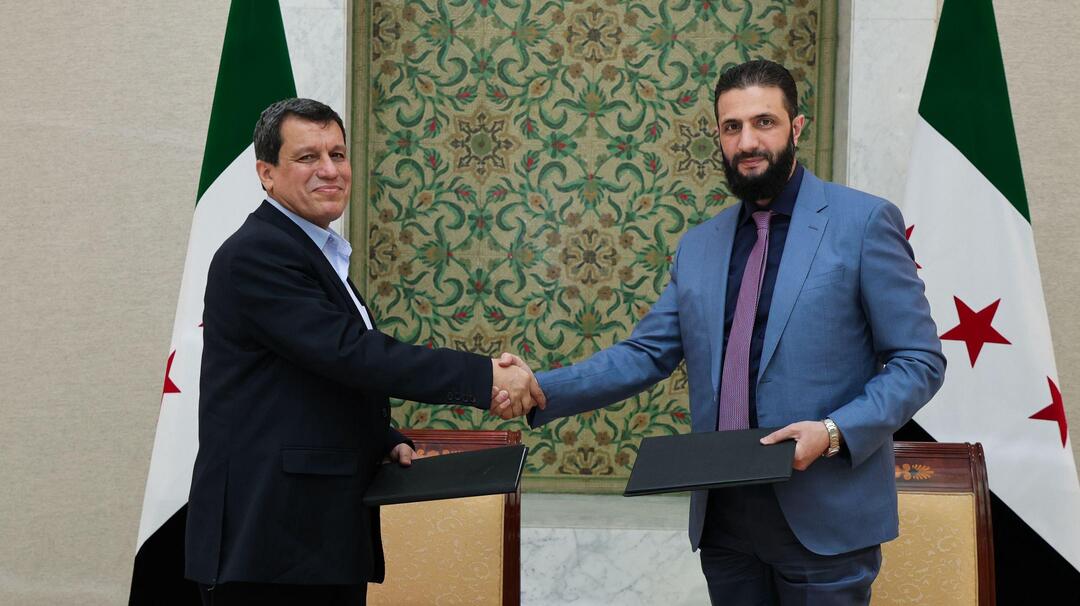-
Damascus-QSD Agreement Continues Despite Rumors of Its Collapse… Ilham Ahmed: 'A Start for Broader Understandings'
-
The new understandings emerge as an attempt to improve living conditions for civilians in the Sheikh Maqsoud and Ashrafiyah neighborhoods, while ensuring their representation in decisions related to s

The Media Directorate in Aleppo denied circulating reports about the suspension of detainee exchanges between the Aleppo Security Directorate and the Syrian Democratic Forces (SDF), confirming that the agreement continues as per the scheduled timeline.
A source from the directorate, as reported by Syria’s official news agency SANA on Sunday, stated that security and logistical arrangements are currently underway to resume exchanges in the coming days—a step reflecting the seriousness of the involved parties in implementing the agreement despite challenges.
These statements came just two days after around 450 QSD fighters left Aleppo in a first batch, in accordance with the agreement stipulating the transfer of the Asayish forces in Sheikh Maqsoud and Ashrafiyah to the Public Security Forces under the Autonomous Administration.
According to Syrian sources, the agreement includes the release of 170 SDF detainees and nearly 400 detainees from the Public Security Administration and other factions—a significant step toward normalizing the situation in the region.
Last Friday, Aleppo witnessed the beginning of the QSD withdrawal, with the first military convoy heading east of the Euphrates under the supervision of the Syrian Ministry of Defense. Meanwhile, Syrian Army units deployed around areas previously under QSD control to secure the departing convoy.
It is worth noting that the Syrian presidency announced on March 10 the signing of an agreement integrating the SDF into state institutions, reaffirming Syria’s territorial unity and rejecting division. The agreement was signed by Acting President Ahmad al-Shar’a and SDF Commander Mazloum Abdi.
Ilham Ahmed, the Co-Chair of the Foreign Relations Office of the Autonomous Administration of North and East Syria, praised the agreement signed in early April in Aleppo, describing it as a new experiment in Syria’s reality that could lead to "building a decentralized, pluralistic state ensuring the return of displaced people and ending armed conflict."
Ahmed called the agreement "positive," stressing that residents of the two neighborhoods had suffered for years from siege and lack of services, and that this understanding would improve their living conditions and provide a more stable environment.
She clarified that the agreement tasks the Asayish forces with protecting the two neighborhoods post-military withdrawal, calling it a necessary step to safeguard civilians from the repercussions of armed conflicts.
She stated: "Protecting civilian lives is essential, and this requires security guarantees from all parties, including the Asayish and official authorities in Aleppo."
Ahmed noted that the local councils in the two neighborhoods would remain operational while initiating direct coordination with the Aleppo Governorate Council in service and health sectors—a civilian-led effort aimed at fair resource distribution.
She emphasized the need to expand such understandings to other parts of Syria and establish constitutional foundations protecting rights and freedoms to prevent the country from sliding back into conflict—highlighting the importance of building on this positive step.
You May Also Like
Popular Posts
Caricature
BENEFIT Sponsors BuildHer...
- April 23, 2025
BENEFIT, the Kingdom’s innovator and leading company in Fintech and electronic financial transactions service, has sponsored the BuildHer CityHack 2025 Hackathon, a two-day event spearheaded by the College of Engineering and Technology at the Royal University for Women (RUW).
Aimed at secondary school students, the event brought together a distinguished group of academic professionals and technology experts to mentor and inspire young participants.
More than 100 high school students from across the Kingdom of Bahrain took part in the hackathon, which featured an intensive programme of training workshops and hands-on sessions. These activities were tailored to enhance participants’ critical thinking, collaborative problem-solving, and team-building capabilities, while also encouraging the development of practical and sustainable solutions to contemporary challenges using modern technological tools.
BENEFIT’s Chief Executive Mr. Abdulwahed AlJanahi, commented: “Our support for this educational hackathon reflects our long-term strategic vision to nurture the talents of emerging national youth and empower the next generation of accomplished female leaders in technology. By fostering creativity and innovation, we aim to contribute meaningfully to Bahrain’s comprehensive development goals and align with the aspirations outlined in the Kingdom’s Vision 2030—an ambition in which BENEFIT plays a central role.”
Professor Riyadh Yousif Hamzah, President of the Royal University for Women, commented: “This initiative reflects our commitment to advancing women in STEM fields. We're cultivating a generation of creative, solution-driven female leaders who will drive national development. Our partnership with BENEFIT exemplifies the powerful synergy between academia and private sector in supporting educational innovation.”
Hanan Abdulla Hasan, Senior Manager, PR & Communication at BENEFIT, said: “We are honoured to collaborate with RUW in supporting this remarkable technology-focused event. It highlights our commitment to social responsibility, and our ongoing efforts to enhance the digital and innovation capabilities of young Bahraini women and foster their ability to harness technological tools in the service of a smarter, more sustainable future.”
For his part, Dr. Humam ElAgha, Acting Dean of the College of Engineering and Technology at the University, said: “BuildHer CityHack 2025 embodies our hands-on approach to education. By tackling real-world problems through creative thinking and sustainable solutions, we're preparing women to thrive in the knowledge economy – a cornerstone of the University's vision.”
opinion
Report
ads
Newsletter
Subscribe to our mailing list to get the new updates!






















